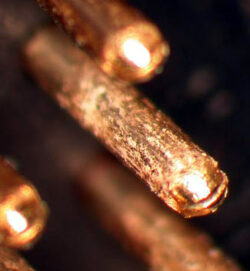Dry Circuit Testing
Have you ever been asked to perform a Dry Circuit Test?
You might respond that dry circuit testing is not a part of the IPC/WHMA-620 test requirements. However, the customer might point out that it IS part of MIL Standard 1344. What do you do? If you build cable and wire harness assemblies should “Dry Circuit Testing” be of concern to you? Dry circuit tests do have their place, but not during the production of cables and harnesses.

What is Dry Circuit Testing?
Dry Circuit Testing is used after Environmental Stress Tests to Detect Contaminates and Oxides on Mating Contact Surfaces.
Typically, a dry circuit test is performed in conjunction with environmental stress tests intended to create contamination or metal oxides on connector contact surfaces. A Dry Circuit test is not particularly relevant until these environmental stresses are applied and the oxides and contaminates are deposited on the contact surfaces.
(Think of deposits built up on a drinking glass subjected to repeated washing and drying cycles in hard water. On electrical contacts, these contaminates interfere with a good connection.)
Low Voltage, Low Current is Used to Avoid “Wiping Away” the Contaminates
Excessive current through the contacts during testing can cause a physical change in the contact area on a microscopic level. Current can cause heating, which can soften or melt the contact points and surrounding area. The contact area enlarges, resulting in a reduction in resistance.
To avoid “wiping away” the contaminates, a dry circuit method is used for testing. A dry circuit is one in which the voltage and current are limited to levels that can’t cause changes in the physical and electrical condition of the contact junction. Generally that means the open circuit voltage is 20mV or less and the short circuit current is 100mA or less.
Why Dry Circuit Testing is not Practical for Production Testing
Contaminates are usually wiped away during connector mating. A “dry circuit test” could be helpful in your production cycle if you were checking for oxides and contaminates on the mating surfaces of your connectors. However, there is one big problem with this idea; the wiping action between mating contacts during connector engagement in production testing usually wipes clean the contaminates, invalidating the test (it would be like testing for the white build-up on a water glass after someone has polished away the hard water deposits with a rag).
The Real Purpose of the Dry Circuit Test in MIL-STD-1344A. Closer reading of the “Dry Circuit Test” in Method 3002.1 of MIL-STD-1344A reveals that this test is part of a specification that is intended for testing of electrical connectors. The title says it all, “Test Methods for Electrical Connectors”. This test actually relates to qualification tests on connectors by the manufacturers of connectors, not on completed cable/harness assemblies.
To our knowledge, it is never a 100% production test even by connector manufacturers. Most often, it is used for qualification for parts and surveillance sampling. If you want to comply with this specification as an assembler of cables/harnesses, you need to use connectors whose manufacturers confirm they meet this specification.
MIL-STD-1344 Method 3002.1 Test parameters are in conflict with practical testing of final assemblies.
Method 3002.1 references the requirements for test equipment in paragraph 2. It specifies a 100mA current with a max voltage of 20mV. This means a pass/fail resistance threshold of 0.2 ohms. This is too low for most completed cable assemblies, yet it is easily within the specification for resistance expected between contact mating pins (the use for which it was intended). Since the bare wire terminated to the contact is not directly accessible for testing a completed cable assembly, the futility of this test in cable/harness production is obvious.


